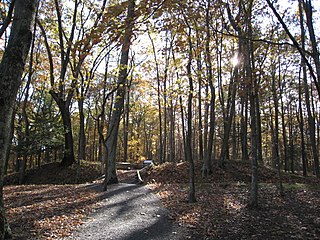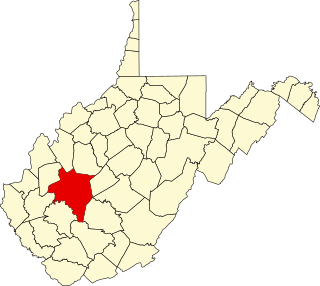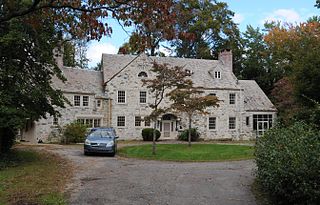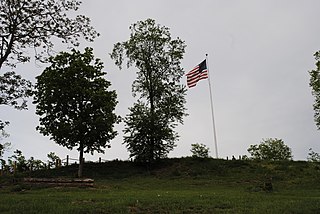
The Fort Mill Ridge Civil War Trenches are battle trenches in West Virginia that were originally dug between 1861 and 1862 to be later used in 1863 for the civil war. These trenches lined with chestnut logs by the Confederate artillery during the American Civil War to defend the approaches to Romney on the Northwestern Turnpike and the South Branch Potomac River. The trenches were then refurbished between March and June 1863 by the 54th Pennsylvania Infantry and the 1st West Virginia Infantry. When Colonel Jacob M. Campbell garrisoned Union forces at Romney, camps were set up at nearby at Mechanicsburg Gap. The Confederates might have created these trenches but all throughout the war the Union had control of these trenches.

The West Virginia State Capitol is the seat of government for the U.S. state of West Virginia, and houses the West Virginia Legislature and the office of the Governor of West Virginia. Located in Charleston, West Virginia, the building was dedicated in 1932. Along with the West Virginia Executive Mansion it is part of the West Virginia Capitol Complex, a historic district listed on the National Register of Historic Places.

Charleston is an Amtrak station in Charleston, West Virginia, United States, that is listed on the National Register of Historic Places and is served by the Cardinal. The Cardinal operates as Train 50 Eastbound towards Washington D.C. and New York City departing Chicago on Saturdays, Tuesdays, and Thursdays. The train operates as Train 51 Westbound towards Chicago departing New York on Wednesdays, Fridays, and Sundays. Trains only operate to the station on Wednesdays, Fridays, and Sundays.

Edward Brickell White, also known as E. B. White, was an architect in the United States. He was known for his Gothic Revival architecture and his use of Roman and Greek designs.

This is a list of the National Register of Historic Places listings in Kanawha County, West Virginia.

Breezemont, also known as the Gen. C. C. Watts House, is a historic home located at Charleston, West Virginia. It was built about 1905 for Cornelius Clarkson Watts (1848–1930) an individual who contributed quite significantly to the history of both Kanawha County and the state of West Virginia. It is located atop Watts Hill overlooking much of Charleston, and is an example of vernacular Neo-Classical architecture.

Barnes-Wellford House is a historic home located at Charleston, West Virginia. It was designed in the 1920s by English-born architect Fred Crowthers for Bernard Barnes, a leading Charleston businessman. The cottage size home is in the English Tudor style.

Cox-Morton House, also known as Home Hall, is a historic home located at Charleston, West Virginia. It was built in 1902, for Frank Cox, secretary of Republic Coal Co., the West Virginia Colliery Co., and the Carbon Coal Co. He was known in West Virginia as the "Great Wildcatter". His daughter Alice Boyd Cox married James Morton of the Morton Coal Co. It is an American Foursquare-style house. It features a ballustrated terrace around two sides of the house and a doric portico, added in the 1920s.

Cox-Parks House is a historic home located at Charleston, West Virginia. Emma Cox, the wife of Frank Cox, leader of several coal companies in the Kanawha Valley, had this home built for herself in about 1925 when she gave the old "Home Hill" to her daughter's family. It is an elaborate bungalow in the Prairie School-style. The exterior features clean white stucco and green tile and a double entrance and flanking double windows, housed by a recessed porch.

Dalgain, also known as the McCabe House, is a historic home located at Charleston, West Virginia. Robert E, McCabe, for whom the house was built in 1916, was a prominent Charleston attorney active in the city's business life. It is an American Foursquare-style house that features a white stucco exterior and green roof.

Stoneleigh, also known as the Charles E. Ward House or Ruffner Payne House, is a historic home located at Charleston, West Virginia. It was built in 1917 as the residence of Charles E. Ward, a leading West Virginia industrialist.

Thomas-McJunkin-Love House is a historic home located at Charleston, West Virginia. It was built for James R. Thomas, president of the Carbon Fuel Company, a coal mining business in the Kanawha Valley. Known originally as "The Maples," it was built for him and his family around 1921. It is in the English Tudor style and features half timbering in some of the gables and brick in others, but the exterior is predominantly in stucco.

Littlepage Stone Mansion, also known as The Old Stone Mansion, is a historic home located at Charleston, West Virginia. It was constructed in 1845 is one of only six houses within the City of Charleston that date to before the American Civil War. It was originally constructed as a two-story Federal style residence, with additions and improvements made in 1915 and 1936.

MacFarland House, also known as MacFarland-Ruby-Crowley-Hubbard House, is a historic home located at Charleston, West Virginia. It was built in 1836 and is one of only six pre-American Civil War houses still standing in the city. The house features a full two-story modified Roman Doric portico.

Grosscup Road Historic District is a national historic district located at Charleston, West Virginia. The district is a neighborhood of 22, 19th and early 20th century residences. They are architecturally and historically significant residences that were, and remain today, the residences of Charleston's prominent industrial, commercial, and political families.

Spring Hill Cemetery Historic District is a national historic district located at Charleston, West Virginia. The district is a 172-acre (70 ha) site located on a series of tree shaded and landscaped hills overlooking central Charleston and includes the following cemeteries: Spring Hill Cemetery, Mountain View Cemetery, B'nai Israel Cemetery, Lowenstein Cemetery, and Mount Olivet Cemetery. It is West Virginia's largest cemetery complex. The district features Spring Hill Mausoleum, a stone faced reinforced concrete structure constructed in 1910. It includes the graves of West Virginia Governors William A. MacCorkle (1857–1930) and George W. Atkinson (1845–1925).

Edgewood, also known as the John Boyd House, is a historic home located at Bunker Hill, Berkeley County, West Virginia. It was built in 1839 and is a two-story, five-bay, brick dwelling with a gable roof in the Greek Revival style. The entrance features a semi-elliptical transom and sidelights. The building has a two-story rear ell. The property includes a small log slave cabin.

Union Civil War Fortification, also known as Bulltown Civil War Site, is a historic archaeological site located near Napier, Braxton County, West Virginia. The site relates to the American Civil War Battle of Bulltown, that took place on October 13, 1863. During test excavations in the 1970s, remnants of structures, features, and artifacts were recovered. The site was purchased by the Army Corps of Engineers during the development of Burnsville Lake, and is administered as part of the Bulltown Historic Area.

Fort Boreman is a historic archaeological site encompassing a Civil War fortification located near Parkersburg, Wood County, West Virginia. It was built in 1863, by Company A of the 11th West Virginia Volunteer Infantry Regiment. It is a series of paired, approximately four foot deep trenches encircling the top of the hill in a zigzag pattern. It was originally built to ensure that the Baltimore and Ohio Railroad link between Wheeling and Parkersburg was not severed or commandeered by the Confederate army. The fort was named after Arthur I. Boreman, West Virginia's first Governor.

Fayetteville Historic District is a national historic district located at Fayetteville, Fayette County, West Virginia. The district encompasses 126 contributing buildings, 4 contributing sites, and 3 contributing structures. It includes the central business district and surrounding residential areas of Fayetteville. Notable buildings include Jack's Garage (1934), Theatre Building (1935), Fayette County Jail (1907), McClung House (1850), Old Methodist Church, Old Post Office (1920), Bank of Fayette-Town Hall (1921), U.S. Post Office (1938), and the War Memorial Building (1949). Also in the district is the site of Fort Toland, site of Fort Scammon and the Old Fayetteville Cemetery. The district includes the separately listed Fayette County Courthouse, E. B. Hawkins House, and Altamont Hotel.






















